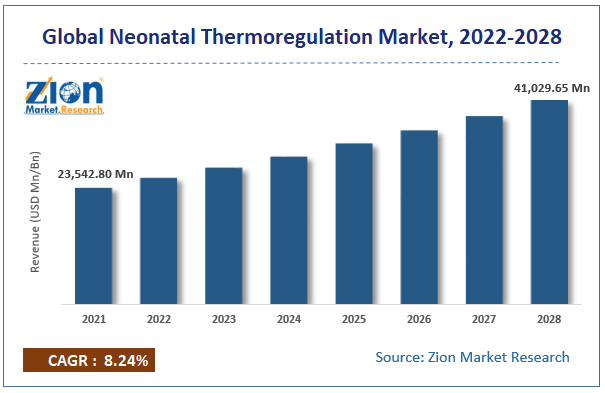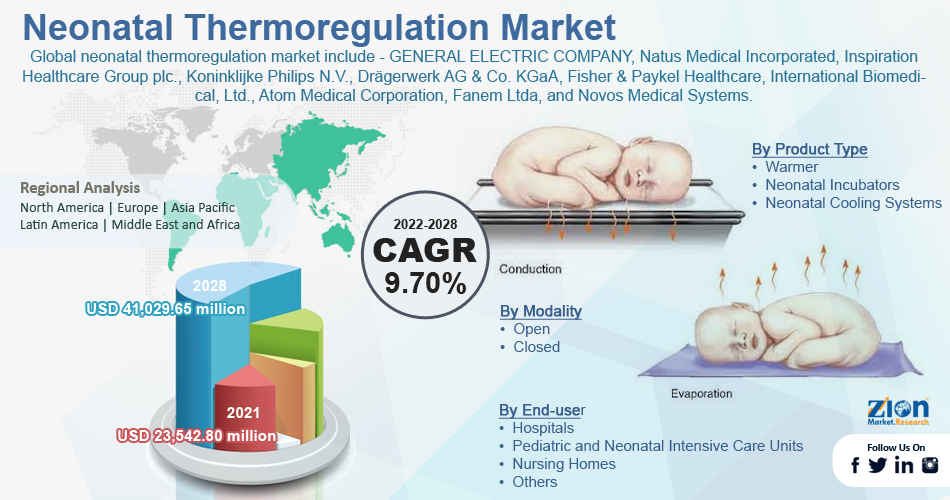Neonatal Thermoregulation Market Size, Share, Trends and Forecast, 2034

Neonatal Thermoregulation Market By Product Type (Warmer, Radiant Warmer, Wall Mount Warmer, Neonatal Incubators, Intensive Care Incubator, Hybrid Incubator, Selective Close Care Incubators, Transport Incubator, Neonatal Cooling Systems), By Modality (Open, Close), End User (Hospitals, Paediatric and Neonatal, Intensive Care Units, Others), and By Region: Global and Regional Industry Overview, Market Intelligence, Comprehensive Analysis, Historical Data, and Forecasts 2025 - 2034
| Market Size in 2024 | Market Forecast in 2034 | CAGR (in %) | Base Year |
|---|---|---|---|
| USD 725.75 Million | USD 1820.04 Million | 9.63% | 2024 |
Neonatal Thermoregulation Market Size And Industry Analysis
The global neonatal thermoregulation market size was worth around USD 725.75 Million in 2024 and is predicted to grow to around USD 1820.04 Million by 2034 with a compound annual growth rate (CAGR) of roughly 9.63% between 2025 and 2034 The report analyzes the neonatal thermoregulation market's drivers, restraints/challenges, and their effect on the demands during the projection period. In addition, the report explores emerging opportunities in the neonatal thermoregulation market.
Neonatal Thermoregulation Market: Overview
Neonatal thermoregulation is a function strongly influenced by physical immaturity, the severity of illness, and other environmental factors. Newborns, especially premature babies, are often at risk for hypothermia within the first 12 hours after birth. During hypothermia, infants lose body heat by four pathways: convection, radiation, conduction, and evaporation. Once the heat is lost, the infant's metabolic system is affected. Devices such as incubators and bottle warmers are widely used to avoid harm to the infant. The rapidly increasing birth rate globally is expected to drive market growth during the forecast period. Furthermore, the availability of state-of-the-art neonatal care facilities is expected to provide significant growth opportunities for companies operating in the global neonatal thermoregulation market during the forecast period.
Key Insights
- As per the analysis shared by our research analyst, the global neonatal thermoregulation market is estimated to grow annually at a CAGR of around 9.63% over the forecast period (2025-2034).
- Regarding revenue, the global neonatal thermoregulation market size was valued at around USD 725.75 Million in 2024 and is projected to reach USD 1820.04 Million by 2034.
- The neonatal thermoregulation market is projected to grow at a significant rate due to rising preterm birth rates, increasing NICU admissions, advancements in neonatal care technology, and growing awareness about hypothermia risks in newborns.
- Based on Product Type, the Warmer segment is expected to lead the global market.
- On the basis of Modality, the Open segment is growing at a high rate and will continue to dominate the global market.
- Based on the End User, the Hospitals segment is projected to swipe the largest market share.
- Based on region, North America is predicted to dominate the global market during the forecast period.
Neonatal Thermoregulation Market: Growth Drivers
The increasing number of newborns aids the global market growth
Several factors will drive the growth of the global neonatal thermoregulation market in the coming years. With the number of newborns increasing, the devices used to draw blood and monitor babies are growing. More and more companies are focusing on developing social devices so that they can be helped to treat different conditions of babies. It is already aware of the devices available in the market. The soaring birth rate in many parts of the world, especially in emerging countries, is estimated to drive the growth of the global market in the coming years.
Neonatal Thermoregulation Market: Restraints
The high-risk involvement may hamper the global market growth
The key restraints for the global neonatal thermoregulation market are the potential risks in infants due to heaters. For instance, the American Academy of Pediatrics (AAP) has stated that the most severe complication of radiant heater use is extreme hyperthermia, which can result from improper use or deviation. Sensor probe, resulting in death or permanent neurological damage in the infant.
Neonatal Thermoregulation Market: Opportunities
The increasing development by market players brings up several growth opportunities
Major companies are also developing intelligent incubators upgraded with advanced technology that can be used for premature babies. Innovative and advanced incubators are created by different manufacturers to protect infants from infection, noise, and cold and can be monitored, providing oxygen while maintaining balance by liquid and drug. Therefore, innovation in product development helps to increase the adoption of neonatal thermoregulation globally.
Neonatal Thermoregulation Market: Segmentation
The global neonatal thermoregulation market is segregated based on product type, modality, end-user, and region.
By product type, the market is divided into warmer, neonatal incubators, and neonatal cooling systems. Among these, the warmer segment dominated the market, accounting for a significant percentage of global sales due to the increasing number of newborns globally.
By end-user, the market is bifurcated into hospitals, pediatric, and neonatal intensive care units, nursing homes, and others. Over the forecast period, the hospital segment is expected to develop faster.
Recent Developments
- April 2022 – G.E. Healthcare developed a Giraffe Incubator Carestation. The Giraffe Carestation is a state-of-the-art neonatal environment that promotes natural and peaceful healing. It nurtures the strong bond between the family and the infant, allowing them to be present at every step.
- April 2022 - Natus Medical Incorporated, a leading provider of medical device solutions for the screening, diagnosis, and treatment of disorders affecting the brain, neural pathways, and eight sensory nervous systems, announced that it entered into a definitive agreement to be acquired by a subsidiary of Natus Medical Incorporated. ArchiMed focuses exclusively on healthcare, with a valuation of around $1.2 billion.
Neonatal Thermoregulation Market: Report Scope
Neonatal Thermoregulation Market: Report Scope
| Report Attributes | Report Details |
|---|---|
| Report Name | Neonatal Thermoregulation Market |
| Market Size in 2024 | USD 725.75 Million |
| Market Forecast in 2034 | USD 1820.04 Million |
| Growth Rate | CAGR of 9.63% |
| Number of Pages | 260 |
| Key Companies Covered | Drägerwerk AG & Co. KGaA, GE HealthCare, Atom Medical Corporation, Phoenix Medical Systems, Natus Medical Incorporated, and others. |
| Segments Covered | By Product Type, By Modality, By End User, and By Region |
| Regions Covered | North America, Europe, Asia Pacific (APAC), Latin America, The Middle East and Africa (MEA) |
| Base Year | 2024 |
| Historical Year | 2020 to 2023 |
| Forecast Year | 2025 - 2034 |
| Customization Scope | Avail customized purchase options to meet your exact research needs. Request For Customization |
Neonatal Thermoregulation Market: Regional Landscape
The presence of market players and advancements help North America dominate the global market
In 2021, North America is expected to dominate the global neonatal thermoregulation market with a well-developed healthcare industry. Government involvement in raising awareness about infant diseases drives the market's growth. For example, the U.S. government has programs such as the Health Resources and Services Administration (HRSA) Genetic Disorders Program and the Screening Quality Assurance Program. Thus, such government and NGOs' initiatives and programs support the market's growth. Europe is expected to occupy the second position in the global market. The market development in this region is due to the availability of funding sources for research.
Asia-Pacific is expected to be the fastest growing region in the market due to the presence of a vast patient population and continuously growing economies. According to a report published by the International Journal of Social and Development Concern, in Malaysia, the growth rate of public primary and secondary care facilities has decreased in recent years. It is not keeping pace with rapid urbanization. As such, these factors are holding back the growth of this regional market. In contrast, the Middle East and Africa have the smallest market share.
Neonatal Thermoregulation Market: Competitive Landscape
The report provides a company market share analysis to give a broader overview of the key market players. In addition, the report also covers key strategic developments of the market, including acquisitions & mergers, new product launches, agreements, partnerships, collaborations & joint ventures, research & development, and regional expansion of major participants involved in the neonatal thermoregulation market on a global and regional basis.
Some of the main competitors dominating the global neonatal thermoregulation market include
- GENERAL ELECTRIC COMPANY
- Natus Medical Incorporated
- Inspiration Healthcare Group plc.
- Koninklijke Philips N.V.
- Drägerwerk AG & Co. KGaA
- Fisher & Paykel Healthcare
- International Biomedical Ltd.
- Atom Medical Corporation
- Fanem Ltda
- Novos Medical Systems
The global neonatal thermoregulation market is segmented as follows:
By Product Type
- Warmer
- Neonatal Incubators
- Neonatal Cooling Systems
By Modality
- Open
- Closed
By End-user
- Hospitals
- Pediatric and Neonatal Intensive Care Units
- Nursing Homes
- Others
By Region
- North America
- The U.S.
- Canada
- Europe
- France
- The UK
- Spain
- Germany
- Italy
- Rest of Europe
- Asia Pacific
- China
- Japan
- India
- South Korea
- Southeast Asia
- Rest of Asia Pacific
- Latin America
- Brazil
- Mexico
- Rest of Latin America
- Middle East & Africa
- GCC
- South Africa
- Rest of Middle East & Africa
Table Of Content
Methodology
FrequentlyAsked Questions
The global neonatal thermoregulation market is expected to grow due to increasing prevalence of preterm births and associated complications, growing awareness regarding neonatal hypothermia, rising investments in neonatal intensive care units (NICUs) and advanced healthcare facilities.
According to a study, the global neonatal thermoregulation market size was worth around USD 725.75 Million in 2024 and is expected to reach USD 1820.04 Million by 2034.
The global neonatal thermoregulation market is expected to grow at a CAGR of 9.63% during the forecast period.
North America is expected to dominate the neonatal thermoregulation market over the forecast period.
Leading players in the global neonatal thermoregulation market include Drägerwerk AG & Co. KGaA, GE HealthCare, Atom Medical Corporation, Phoenix Medical Systems, Natus Medical Incorporated, among others.
The report explores crucial aspects of the neonatal thermoregulation market, including a detailed discussion of existing growth factors and restraints, while also examining future growth opportunities and challenges that impact the market.
RelatedNews
HappyClients
Zion Market Research
Tel: +1 (302) 444-0166
USA/Canada Toll Free No.+1 (855) 465-4651
3rd Floor,
Mrunal Paradise, Opp Maharaja Hotel,
Pimple Gurav, Pune 411061,
Maharashtra, India
Phone No +91 7768 006 007, +91 7768 006 008
US OFFICE NO +1 (302) 444-0166
US/CAN TOLL FREE +1 (855) 465-4651
Email: sales@zionmarketresearch.com
We have secured system to process your transaction.
Our support available to help you 24 hours a day, five days a week.
Monday - Friday: 9AM - 6PM
Saturday - Sunday: Closed






